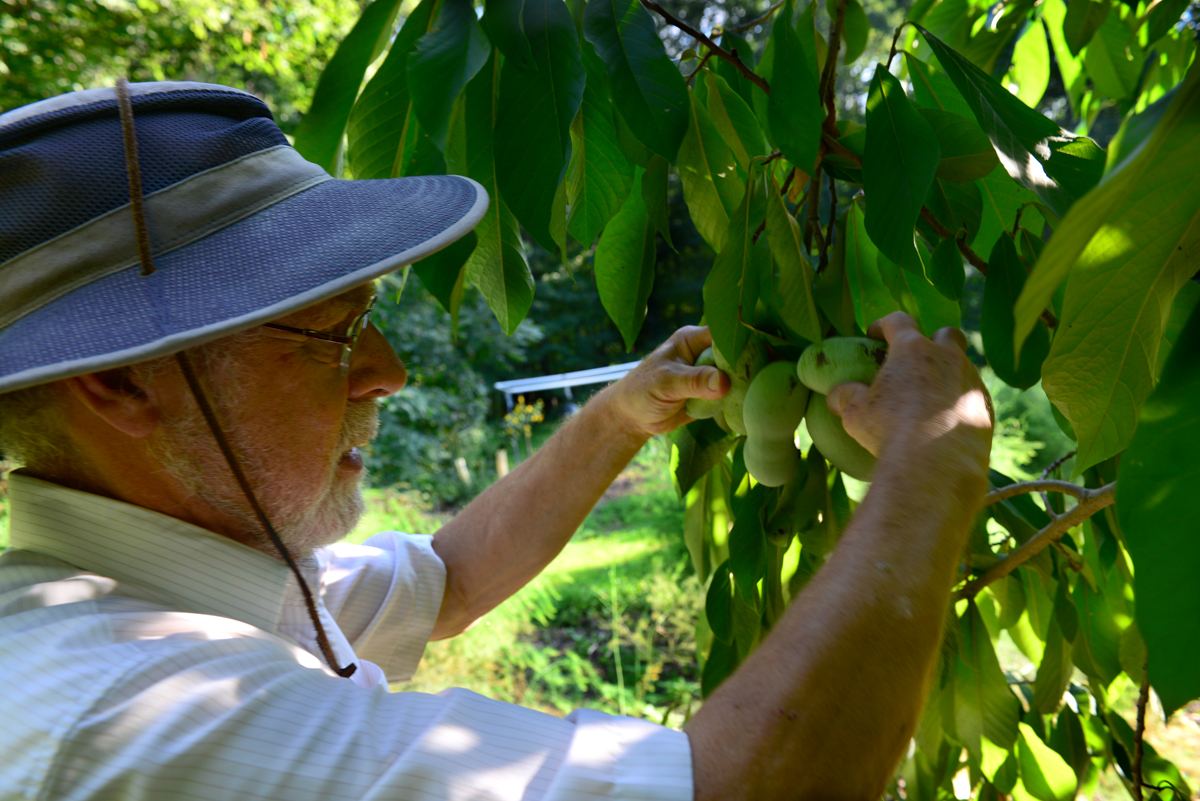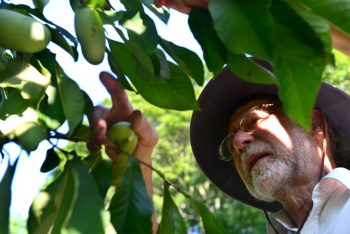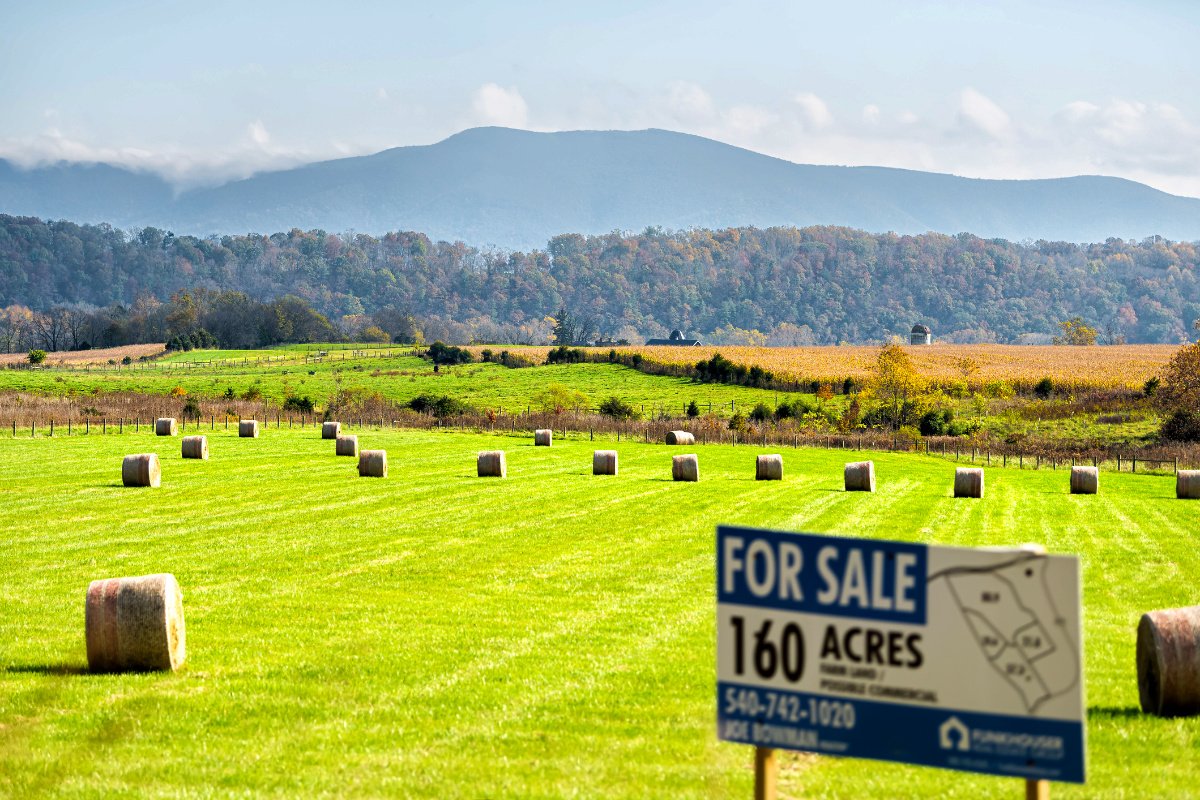The native tropical fruit may soon have a broader growing range as the climate changes, providing a potential new cash crop.

The native tropical fruit may soon have a broader growing range as the climate changes, providing a potential new cash crop.
January 9, 2020

“Please don’t write about my farm” is a rare response for a reporter to get, but such was the case when I inquired about the 2019 pawpaw crop at Rocky Point Farm, and the reason became clear quickly: not enough supply and overwhelming demand.

Joe Gouveia and Rhonda Shumaker of Rocky Point Farm.
“We get bombarded by people each year who want to buy the pawpaws. It is a nerve-wracking experience to not have enough to go around,” explained Rhonda Shumaker. In 2012, along with her partner Joe Gouveia, Shumaker bought the Rhode Island farm, which mainly grows blueberries.
“We have a huge following for the pawpaws and have a line of 40 or more people waiting when we open. We sell out in a few minutes on most days.”
Also called the Indiana banana or the American custard apple, the pawpaw is the largest native North American fruit and has a legendary flavor—many describe it as a cross between a banana and a mango. Pawpaws are commonly available in the heart of their original range, from the Gulf Coast Plain to the Lower Midwest and east to the Mid-Atlantic states, but they’ve approached mythical status in the northeastern states due to a nearly complete lack of availability and shelf life of just a few days.
Although pawpaw trees look tropical and the fruit tastes exotic, they are adapted to cold climates. They can survive temperatures of -25°F without damage, are grown as far north as Ontario, and need a period of freezing for their seeds to germinate. And climate change may open up new regions for prospective pawpaw growers: a recent Harvard Extension feasibility study notes that while they’re already viable in much of the region, their range is likely to grow.
“Almost the entirety of New England will be well within the ideal growth range for pawpaw within the next 30 years,” wrote study author Anna Frej.
Other recent climate projections advise that New England’s growing season is also lengthening faster than other regions, which could move late fruits like pawpaws onto more growers’ lists of possible crops. Coupled with the high demand, many believe this is a good time for New England growers and gardeners to consider the pawpaw more seriously.

A 1999 map of the pawpaw’s natural growing range. (USGS illustration)
Rocky Point is the only retail operation in New England with a sizable and predictable annual pawpaw crop, leading fans of the fruit to drive from all over New England—as far away as Pennsylvania, a four-hour drive one way at minimum—to buy sacks of them for smoothies, jams, ice cream, or eating fresh with a spoon (custard apple is an apt name). The timing of the harvest is hard to predict, so the farm posts dates on its website for buying them on a first-come, first-served basis.
Last year, there were just six days slotted for public pawpaw procurement, and the farm’s website advises customers to “come early.” After their first day of sales on October 2, Shumaker reported there were 17 people waiting in line when the stand opened, and that all 40 pounds of ripe pawpaws were gone within minutes. (Late last year, the couple put the farm up for sale, looking for the next generation of pawpaw farmers to take over.)
New England chefs are particularly eager to buy local pawpaws. Marc Sheehan is chef/co-owner of Loyal Nine in Cambridge, Massachusetts, and he first worked with pawpaws while at Blue Hill at Stone Barns in Tarrytown, New York. Though he has bought the fruit from Rocky Point in the past, he’s hoping to find a more regular supply in the future.
“They are unlike any other native fruit; custardy, bright, and juicy. I prefer them raw when absolutely ripe, but they are great in baked goods, as ice cream or sorbet, with fatty pork or smoked or raw fish,” says Sheehan. They can easily replace banana, apple sauce, or pumpkin in baked goods, he adds, noting that he can get raw, frozen pawpaw pulp from elsewhere but prefers to buy local.
“They are one of my ‘holy grail’ ingredients,” he says.

Added to Slow Food USA’s Ark of Taste in 2004, pawpaws have been on the radar of John Forti, board chair of the Slow Food chapter covering coastal New Hampshire and Maine, for far longer. The director of Bedrock Gardens, a 35-acre garden education center in southeastern New Hampshire, Forti started growing pawpaws because he likes them, but also because he feels it’s important to experiment with more southerly crops due to the changing climate—including figs and kiwi.
In early November, Forti delivered a sack of his pawpaws to Evan Mallett, chef/owner of Black Trumpet in the tony seaside town of Portsmouth, New Hampshire. Mallett says he’s worked with them for years, often blending them into ice cream and custards, or used them as a thickener in sauces like crème anglaise.
“Without a doubt, I’d buy more,” Mallett said when asked if these uses were limited by supply. A member of the local Slow Food board with Forti, Mallett is similarly devoted. “Pawpaws may be virtually commercially extinct, but they’re a national treasure,” he said.
Are pawpaws worth the investment for farmers? While Rocky Point farm only harvested about 100 pounds this year, down from last year’s 600 pounds, they sold all of them at $5 per pound. Though farmer Gouveia estimates this accounts for less than 1 percent of the farm’s income, it’s a nice extra boost for the small farm.
Frej’s Harvard study focused on small growers like Shumaker and Gouveia, since New England’s farms are typically family affairs of fewer than nine acres, but she was able to show that it can be profitable even at the scale of one acre: “Given the assumed cost and revenue streams over 15 years… pawpaw would be a financial success,” she says.
| A Primer on Growing Pawpaws by Erik Hoffner |
|---|
Frustrated by my own inability to buy pawpaws anywhere, I planted a few trees in 2009, which finally set fruit for the first time in 2019—ten years of waiting, including two previous years of fruitless flowering—despite hand-pollinating the lower flowers and doing everything I could to attract natural pollinators. Baiting pawpaw pollinators with raw bacon. My experience notwithstanding, pawpaws can be quite simple to grow, and organically, too, since they largely lack pests. A generous friend in a nearby town, Jack Lochhead, who recently began giving me a sack of them each year from his prolific trees, agrees: “They’re simple to grow, the only hassle is the sprouts constantly coming up,” he said of their incessant suckering. Asked about other maintenance, the retired math professor and backyard orchardist added, “I don’t know if pruning helps, except to keep the trees from getting too tall, and sometimes we have to thin the fruit,” since his trees can be so laden that their branches will break. Cornell Cooperative Extension in upstate New York advises growers on pawpaws, and Schuyler County extension agent Roger Ort, who likes offering guidance on diversifying orchards with crops like persimmons and June berries, is likewise a big believer in pawpaws: “It’s a new economic crop for this area…a real opportunity for growers,” he says. Ort stewards quite a few trees of his own for making the pawpaw jam sold by his farm, and says the main initial decisions are location specific: after consulting Kentucky State University (KSU)’s indispensable pawpaw research program’s website for the growing basics, he recommends choosing a warm and protected spot to aid late ripening, and to minimize dangerous winter temperatures and damaging winds.  Jack Lochhead inspecting a pawpaw tree. That’s important because grafts can die in severely cold weather, as explained by Andrew Moore, author of the essential 2015 book about pawpaw culture and history, Pawpaw: In Search of America’s Forgotten Fruit. While his trek reporting the book took Moore mainly through the core, more southerly pawpaw growing regions of the country, he’d heard of graft deaths in the Upper Midwest, a phenomenon which members of a Wisconsin permaculture message board also discussed happening in zone 4b areas of southern Minnesota. A 2003 Cornell study in zone 5b New York backs this up. Despite the somewhat higher mortality in the grafted trees, lead author Ian Merwin said, “When a grafted tree died, its roots would quickly regrow. Pawpaws produce suckers profusely from their root systems, so the impact on fruit production was minimal.” Trees grown from seed are generally cheaper, too, especially if you sprout them yourself, but the main downside is that there is enough genetic variability in pawpaws that one has to gamble, since the outcome fruit-wise can’t be known for at least four years (or actually more, as KSU Pawpaw Program’s Extension Associate Sheri Crabtree reports seedling trees take up to eight years to produce fruit). When asked what varieties KSU would recommend for New England, Crabtree said, “For short growing seasons or areas with cool summers where pawpaws may not get enough growing-degree days, early ripening cultivars are best. KSU-Benson, Pennsylvania Golden, and Summer Delight are some of the earliest.” For its part, Cornell’s horticulture program suggests Davis, Sunflower, Taylor, and Taytwo as varieties for New York growers. |
Top photo: Jack Lochhead inspecting a pawpaw tree. All photos by Erik Hoffner.

October 9, 2024
In this week’s Field Report, MAHA lands on Capitol Hill, climate-friendly farm funding, and more.
October 2, 2024

October 2, 2024

October 1, 2024

September 24, 2024

September 18, 2024

Have only had a few out of the older tree. Located NE of Atlanta Georgia.
Brother in law was able to find some on a local farm in Rhode Island . Delicious.